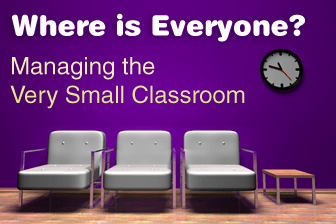Whatís Your Passion? 7 Individual Projects to Tap into Learner Motivation


“How many students are in your class?” another teacher asked me at a faculty meeting recently.
“Six,” I replied. “Or, no, maybe seven—I’m getting another one on Monday.”
“Seven? That’s a dream! I could do so many things with seven students.”
“Yeah,” I said. “I know. We’ve already done them. I have no idea what we’re going to do tomorrow.’
The class is so small that everyone gets to know everyone else very quickly. You can race through lessons in half the time you usually would, leaving nothing to do. Even entire units of study seem to require a fraction of the time.
So what is there to do, when it seems you’ve already done everything?

In a very small class, there is opportunity for individual tutoring and learning plans. So at the beginning of the semester, after the initial diagnostic, the teacher can sit with each student individually and find out what he or she is interested in working on. The teacher might then find that Felix, for example, is a high intermediate student, as revealed by his diagnostic, and that he is comfortable with his reading and writing skills in English but wants to work on his pronunciation and conversational English. The teacher can then set up a plan to help Felix improve his spoken English skills by completing specific activities in and out of class, perhaps studying with one or two students who are working toward the same goals, while the rest of the students may be working on other material that focuses on their goals.
Devote one day a week—perhaps Friday—to watching a movie. Leading into the movie the rest of the week, students can prepare by doing activities related to the movie, such as learning related background information and vocabulary. In this way, students are completely prepared by the time Friday rolls around. They can then watch the movie and follow it up, on subsequent days, with discussion and written reviews.
Devote a month or two to reading a short novel such as Fitzgerald’s “The Great Gatsby” or Capote’s “Breakfast at Tiffany’s.” Activities should lead into it-- teaching students about Fitzgerald’s New York of the 1920’s, for example, to establish context. There are also activities to do during the novel, to monitor students’ progress, such as discussions, comprehension checks, and vocabulary learning. Finally, there are end-of-novel activities, to wrap things up and do a final assessment. Students can do a presentation, even, on aspects of the novel, such as what Prohibition was or different interpretations of the American Dream.
We all have individual interests or passions that we’d like look into more—if we had the time. Some of the things I’d research if I had time are forensic linguistics, the history of the Russian empire, and the early history of humankind. Students also have similar passions, whether it is the Olympic sport of pole vaulting or wind turbine energy—two recent student research topics. The important thing is that the student be truly passionate about this, enough to spend significant time researching it and then presenting findings to her peers. If two or students are interested in the same topic, they can team up, researching different aspects of the same topic. The teacher can act as a facilitator, giving students the major control of the project while focusing on offering support by giving mini-lessons on research skills, such as how to divide up the labor and in what order, how to find reliable sources, how to synthesize findings, and so on.
Writing, as all students know, takes a lot of time and work to make significant progress on. There is no magic writing pill that will substitute for this. So the small class, where time sometimes seems to hang heavy, is the ideal opportunity to work on writing. At the beginning of the term, the students can help brainstorm topics they’d like to write about or select from a list presented by the teacher. If there is student input on the topics, they are much more interested in them. Once the topics are decided upon, students can spend the term discussing and writing about them. Multiple drafts of each essay can be assigned, different drafts focusing on ideas, organization, and editing and proofreading. At the end of the term, each student will have a “portfolio” of his or her work and can see the progress from the first to final drafts. This amount of writing is usually not possible in a larger class because of the additional time needed to teach every step of the process and also to mark the papers.
Finally, there is a great opportunity for field trips with a small class. I’d balk at “riding herd” on thirty students in a public place; with ten students, it is much less of a concern. And even in my city of Sacramento, California—not a tourist destination—there is still plenty to see: the capitol of the largest state in the U.S.; Sutter’s Fort, where the West began; the railroad museum at what was terminus of the transcontinental railroad. I’ve even taken beginning ESL students to a local shopping mall and found that many had not been to one before. Field trips are a great opportunity for hands-on learning of language, culture, and history.
Small classes present a great opportunity for in-depth and individualized learning that usually doesn’t exist in larger classes.
What are your thoughts on small classes? Do you have special activities for them?